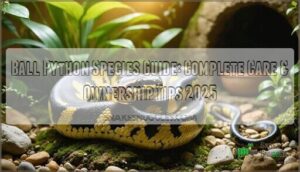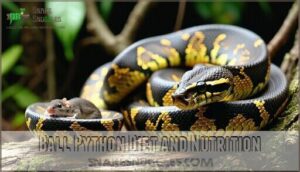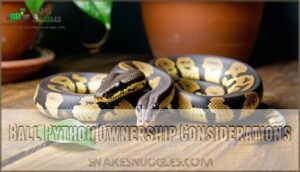This site is supported by our readers. We may earn a commission, at no cost to you, if you purchase through links.

You’ll find these docile snakes surprisingly easy to care for once you understand their needs.
They typically grow 3-5 feet long and live 20-30 years with proper care.
Your ball python species guide should cover essential housing requirements like maintaining 78-80°F ambient temperatures, 50-60% humidity, and appropriately sized hiding spots.
They eat pre-killed rodents every 1-2 weeks, depending on age and size.
While generally hardy, they can be picky eaters and sensitive to environmental changes.
The secret lies in understanding their natural behaviors and creating the right environment from day one, which is crucial for their well-being and proper care.
Table Of Contents
- Key Takeaways
- Ball Python Overview
- Ball Python Care Basics
- Ball Python Diet and Nutrition
- Ball Python Health and Maintenance
- Ball Python Ownership Considerations
- Frequently Asked Questions (FAQs)
- What is a ball python Care Guide?
- Are ball pythons small?
- Where do ball pythons live?
- What is a ball python?
- How many ball pythons are there?
- Are ball pythons solitary animals?
- How many types of ball pythons are there?
- How do I identify my ball python?
- Can a ball python live in a 4x2x2?
- What does 66 het mean?
- Conclusion
Key Takeaways
- You’ll need a 4x2x2 foot enclosure minimum with temperature zones ranging from 75-92°F and humidity between 50-60% to keep your ball python healthy and comfortable.
- Your snake will eat pre-killed rodents every 1-2 weeks depending on age – juveniles need weekly feeding while adults can go 2-4 weeks between meals.
- Ball pythons are docile, long-lived companions that’ll be with you for 20-30 years, making them excellent beginner reptiles if you’re ready for the commitment.
- You’re looking at $500-800 initial setup costs plus $200-300 annually for food and supplies, so budget accordingly for this multi-decade investment.
Ball Python Overview
Ball pythons combine gentle temperament with striking beauty, making them ideal reptile companions for both beginners and experienced keepers.
You’ll discover these medium-sized African natives grow 3-5 feet long and display remarkable genetic diversity through thousands of captive-bred color patterns.
Physical Characteristics
Your ball python’s scale patterns form distinctive markings across their stocky body, with color morphs ranging from earth-toned browns to exotic designer varieties—over 6,500 known ball python morphs exist today.
Their triangular head shape sits atop smooth scales, creating the classic ball python appearance that defines snake morphology.
Sexual dimorphism becomes obvious as females typically stretch 4-5 feet while males stay compact at 3 feet, showing clear body size differences.
Temperament and Behavior
Your ball python’s docile temperament makes them perfect beginner pets, especially when you understand their unique defensive mechanisms.
When stressed, they demonstrate defensive balling – curling into a tight sphere with their head protected inside.
Here are three key temperament types you’ll observe:
- Calm explorers – confident snakes that enjoy gentle ball handling sessions
- Shy hiders – prefer quiet environments and minimal social interaction
- Defensive ballers – frequently curl up when feeling threatened or overwhelmed
Understanding snake behavior helps you recognize stress signals during handling techniques, building trust through consistent, gentle ball python behavior patterns.
Proper care involves creating a suitable environment that promotes healthy behavior patterns.
Habitat and Distribution
 View On Amazon
View On Amazon These magnificent snakes call Sub-Saharan Africa home, where African Grasslands meet diverse ecosystems.
Understanding their natural ball python habitat helps you create ideal captive conditions that mirror their wild environment.
- Semi Arid grasslands with scattered acacia trees and rocky outcrops
- Forest Edges where woodlands shift to open country near farms
- Savanna Regions featuring seasonal rainfall and natural burrow systems
- Semiarid grasslands with termite mounds providing shelter opportunities
- Areas with consistent temperatures ranging from 75-95°F year-round
Ball Python Care Basics
Creating the right environment for your ball python isn’t rocket science, but getting the basics wrong can turn your scaly friend into a stressed-out noodle who refuses to eat.
You’ll need to master three key areas: proper enclosure setup with temperature gradients, humidity control that won’t leave your snake looking like a raisin, and feeding schedules that keep your python healthy without turning them into a chunky tube.
Enclosure Size and Temperature
Setting up your ball python’s enclosure correctly means getting the tank size and temperature gradients just right. Your adult snake needs at least a 48" x 24" x 24" terrarium – think of it as their personal apartment with different climate zones.
Heat sources like ceramic emitters or radiant heat panels work best for creating proper temperature zones. Your ball python care routine should include monitoring these gradients daily using digital thermometers.
Ventilation systems guarantee fresh air circulation while maintaining stable humidity levels. Never skip the thermostat – it’s your safety net against dangerous overheating that could harm your snake.
| Enclosure Zone | Temperature Range | Equipment Needed |
|---|---|---|
| Basking Surface | 88-92°F | Overhead heating |
| Warm Hide | 86-90°F | Under-tank heater |
| Ambient Air | 80-85°F | Natural gradient |
| Cool Side | 75-80°F | Passive cooling |
| Nighttime Drop | 70-78°F | Timer controls |
For peak health, consider the ball python size guidelines when selecting an enclosure.
Your reptile enclosure becomes a thriving habitat when temperatures stay consistent across these zones.
Humidity and Lighting Requirements
Your ball python’s humidity levels thrive between 50-60%, creating the perfect environment for healthy shedding and respiratory function.
Use a reliable hygrometer to monitor moisture management accurately, then boost humidity management through misting or larger water bowls when needed.
Unlike many reptiles, ball pythons don’t require UVB lighting or specialized reptile lighting—simple room lighting provides adequate lighting options for natural day-night cycles.
Focus your temperature control and ventilation systems on maintaining consistent humidity rather than complex lighting setups.
Accurate hygrometer device readings are vital for maintaining ideal humidity levels in your ball python’s enclosure, utilizing a hygrometer device to guarantee precise measurements.
Feeding and Watering Needs
Your ball python diet relies on frozen-thawed prey matching their midsection thickness—carnivores need precise prey size for ideal health.
Follow a consistent feeding schedule: juveniles every 7-10 days, adults every 14-21 days.
Water quality matters—provide fresh, chlorine-free water in a soaking-sized bowl, changed daily for proper hydration tips.
Don’t panic during natural winter fasting periods when healthy pythons refuse meals.
Understanding ball python feeding is vital for maintaining a healthy and thriving pet.
Ball Python Diet and Nutrition
Understanding your ball python’s dietary needs is essential for keeping your scaly friend healthy and thriving.
Unlike dogs who’ll eat anything that hits the floor, ball pythons are surprisingly picky eaters with specific nutritional requirements that change as they grow.
What Does a Ball Python Eat?
Every carnivorous predator needs the right fuel, and your ball python’s rodent diet is surprisingly straightforward. These snakes thrive on whole prey like mice and rats, with prey size matching your snake’s thickest body section.
Frozen vs live debates favor pre-killed options for safety and convenience. Your snake’s feeding habits mirror their wild nutrient needs – they’re built for infrequent, substantial meals rather than daily snacking.
Here’s your prey selection essentials:
- Choose rodents 1.5 times wider than your snake’s midsection
- Thaw frozen prey completely before feeding using warm water
- Use feeding tongs to present meals safely and avoid accidental strikes
Feeding Frequency Based on Age
Your feeding schedule evolves as your ball python matures.
Hatchling feeding starts every 5 days, shifting to weekly meals for juvenile ball pythons.
Adult ball pythons eat every 14-30 days, matching their slower metabolism and growth rates.
| Age Group | Feeding Frequency | Body Weight % |
|---|---|---|
| Hatchlings (0-5 months) | Every 5 days | 10-15% |
| Juveniles (5-12 months) | Every 7 days | 10-15% |
| Subadults (1-3 years) | Every 10-14 days | 5-7% |
| Adults (3+ years) | Every 14-30 days | 5% or less |
Understanding age based feeding prevents overfeeding while supporting healthy snake nutrition throughout your python’s life stages.
To facilitate optimal health, it’s vital to follow proper feeding frequency guidelines to meet your ball python’s nutritional needs.
Prey Items and Supplements
Proper prey selection forms the foundation of successful ball python ownership. Choose frozen vs live rodents carefully—frozen-thawed options eliminate injury risks while maintaining essential nutrients for these carnivorous predators.
Prey size should equal 10-15% of your snake’s body weight. Rodent types include mice, rats, and occasionally day-old chicks for variety. Adult females need mice or small rats, while juveniles thrive on appropriately-sized pinkies or fuzzies.
Feeding techniques matter: use feeding tongs and establish consistent schedules to prevent overfeeding. Supplement needs include occasional calcium dusting, especially for breeding females. Quality frozen feeders from reputable suppliers guarantee a healthy nutrient balance and diet and nutrition success for your python’s long-term health.
Ball Python Health and Maintenance
Maintaining your ball python’s health requires understanding common issues and proper care techniques that can prevent most problems before they start.
You’ll need to master humidity control, recognize shedding cycles, and learn safe handling methods to keep your snake thriving for decades.
Common Health Issues
While good nutrition supports overall ball python health, understanding common health issues helps you spot problems early.
Respiratory infections are the biggest threat—you’ll hear wheezing or see mouth breathing when temperatures drop too low. Scale rot shows up as dark, musty-smelling belly scales from excessive moisture. Bacterial infections often follow stress or poor husbandry practices.
Watch for these warning signs:
- Wheezing sounds during breathing
- Discharge from mouth or nostrils
- Dark, damaged belly scales
- White patches around the mouth
- Excessive soaking behavior
Parasites like mites appear as tiny moving specks, while shedding problems indicate humidity imbalances. Metabolic diseases develop from improper temperatures over time. Most reptile health issues stem from environmental problems—fixing your setup often solves the problem faster than medication alone.
Shedding and Humidity Requirements
Ball python shedding happens every 4-8 weeks for adults, more frequently for juveniles during growth spurts.
You’ll need to maintain specific humidity management throughout this process.
| Shedding Stage | Humidity Requirements |
|---|---|
| Normal periods | 50-60% baseline levels |
| Pre-shed (blue phase) | Increase to 65-70% |
| Post-shed recovery | Return to 50-60% |
Watch for cloudy eyes and dull skin—signs your snake’s entering the shedding process.
Proper misting and hydration needs become critical now. Create a humidity hide with damp moss to support skin health during this vulnerable time.
Maintaining essential humidity levels is vital for preventing shedding problems and ensuring the overall health of your ball python.
Handling and Support Techniques
When handling your ball python, approach with confidence but move like you’re carrying precious cargo. Gentle handling starts with supporting their body across multiple points rather than grabbing randomly. Safe restraint involves distributing weight evenly while avoiding the head area completely.
Proper snake support techniques build trustbuilding moments:
- Use both hands to cradle their midsection and support their weight
- Move slowly and deliberately, letting them settle before repositioning
- Never grab near their head or tail – think gentle scooping motions instead
Watch for stress reduction cues like defensive balling. These handling tips create positive reptile care support experiences that strengthen your ball python handling skills and snake safety knowledge over time.
Ball Python Ownership Considerations
Before you commit to a ball python, you’ll need to honestly assess whether you’re ready for a 20-30 year commitment.
This assessment is crucial because these snakes aren’t impulse purchases—they require consistent temperature control, regular feeding schedules, and veterinary care.
The costs of this care can add up to several hundred dollars annually, making it a significant financial investment that should not be taken lightly, as the snakes require proper care.
Is a Ball Python Right for You?
Deciding whether you’re ready for ball python care requires honest self-reflection about your responsibility level and lifestyle. These gentle snakes aren’t impulse purchases—they’re 20-30 year commitments that’ll outlive many pets.
Before bringing home your scaly friend, consider your owner lifestyle carefully. Ball pythons need consistent temperatures, regular feeding schedules, and ongoing veterinary care that impacts pet costs substantially. You’ll spend roughly $500-800 initially, plus $200-300 annually for food and supplies.
Snake handling intimidates some people, but ball pythons are forgiving teachers for beginners. Their docile nature makes them excellent starter reptiles, though you’ll need patience during their shy phases.
Key factors for successful ownership include:
- Space availability for a minimum 40-gallon setup with proper heating systems
- Family acceptance since some relatives might feel squeamish about your new companion
- Financial stability to handle unexpected veterinary bills and equipment failures
Your longterm commitment determines whether this beginner reptile becomes a rewarding companion or overwhelming burden.
Choosing a Pet Ball Python
Selecting the right snake means finding breeders who prioritize health over profit margins.
Look for responsive Python regius displaying bright eyes and smooth scales without retained shed patches.
Reputable breeder selection involves asking about health records, feeding histories, and Ball Python Morphs genetics.
When handling potential pets, observe feeding responses and check for mites carefully.
Beginner reptile enthusiasts should prioritize docile temperaments over flashy patterns.
Consider Pet Insurance options early, as snake handling injuries occasionally require veterinary attention.
It’s also essential to research and understand the costs associated with Ball Python Pets care and maintenance.
Health Indicators Breeder Questions Selection Tips
Cost and Lifespan Expectations
Commitment runs deeper than the snake’s striking appearance. You’re looking at a ball python cost ranging from $25-$500+ for initial purchase, plus setup expenses hitting $300-$1,000. Monthly expenses typically run $25-$60 for food, substrate, and utilities.
Here’s what drives ownership costs over time:
- Initial cost varies wildly—standard morphs cost $60-$100, while rare genetics exceed $1,000
- Longterm expenses include $100-$150 annually for food plus substrate replacements
- Average lifespan reaches 20-30 years in captivity, with records hitting 62 years
- Lifespan factors depend on proper temperature, humidity, diet, and veterinary care
- Longevity expectations mean decades of commitment—plan your budget accordingly
Your ball python lifespan expectations should account for this multi-decade partnership requiring consistent care and financial planning.
Frequently Asked Questions (FAQs)
What is a ball python Care Guide?
A ball python care guide covers essential housing requirements, feeding schedules, temperature gradients, humidity levels, substrate choices, health monitoring, and handling techniques to keep your pet snake healthy and thriving.
Are ball pythons small?
Like a coiled spring in nature’s toolbox, you’ll find ball pythons aren’t exactly small snakes. Females reach 4-5 feet while males stay around 3 feet, making them medium-sized serpents.
Where do ball pythons live?
You’ll find ball pythons naturally roaming sub-Saharan Africa’s grasslands, savannas, and sparse woodlands from Senegal to Uganda, where they cozy up in mammal burrows and hollow logs.
What is a ball python?
Picture a coiled spring with scales—that’s a ball python, your docile African companion. You’re looking at medium-sized constrictors reaching 3-5 feet, famous for curling into defensive balls when stressed.
How many ball pythons are there?
Currently, there’s only one ball python species – Python regius. However, you’ll discover approximately 6,500 captive-bred morphs exist, creating incredible variety in colors and patterns through selective breeding programs worldwide.
Are ball pythons solitary animals?
As lone wolves of the reptile world, you’ll find ball pythons are naturally solitary creatures who prefer their own company, only seeking companionship during breeding season.
How many types of ball pythons are there?
You’ll encounter thousands of ball python varieties! There are approximately 6,500 known morphs created through selective breeding, each displaying unique colors and patterns that’ll make your head spin with possibilities.
How do I identify my ball python?
You can identify your ball python by examining its triangular head, stocky build, and distinctive brown patterns with lighter belly coloration.
Check the size—males typically reach 2-3 feet while females grow 3-5 feet long, which can help you further identify your ball python.
Can a ball python live in a 4x2x2?
Studies show 4x2x2 enclosures perfectly suit adult ball pythons, meeting their space requirements.
You’ll provide adequate room for temperature gradients, hiding spots, and natural movement patterns—your python will thrive comfortably in this appropriately-sized home.
What does 66 het mean?
66 het" means you’ve got a ball python that’s heterozygous for a specific gene, carrying one copy of that trait.
It’ll pass the gene to roughly 66% of its offspring when bred with another carrier.
Conclusion
Successfully caring for your new scaly companion feels like solving a fascinating puzzle, doesn’t it?
With this thorough ball python species guide, you’re equipped with everything needed to provide excellent care for these remarkable reptiles.
Remember that consistency in temperature, humidity, and feeding schedules creates the foundation for a thriving snake.
Your patience during the adjustment period will pay off with decades of rewarding companionship from one of nature’s most enchanting creatures.














